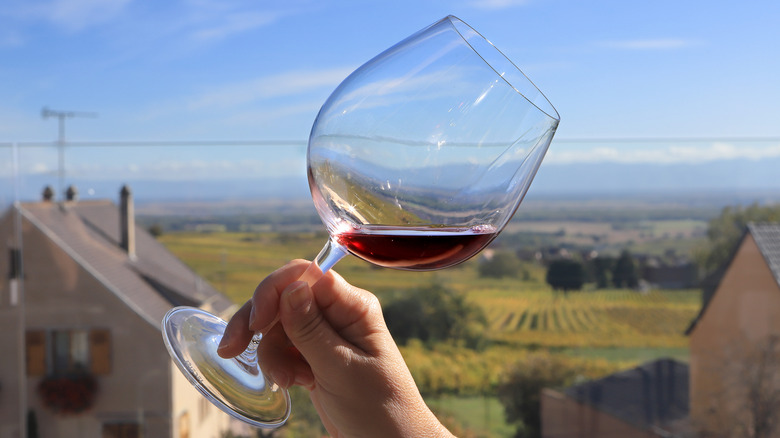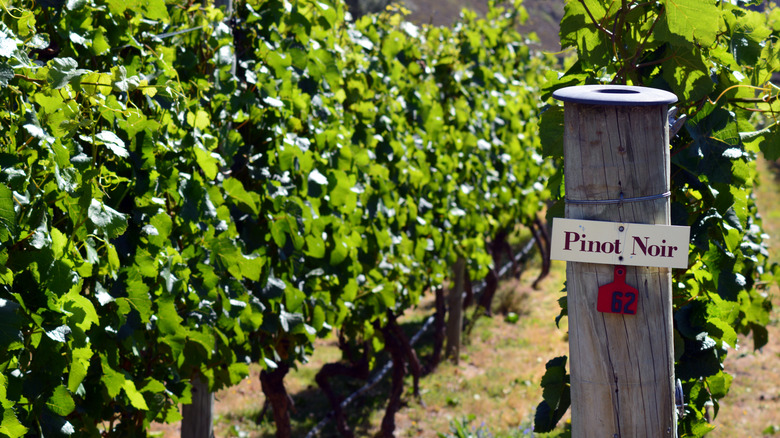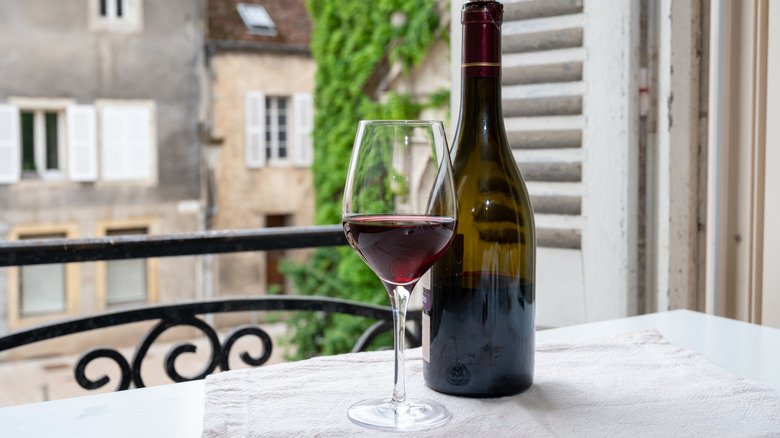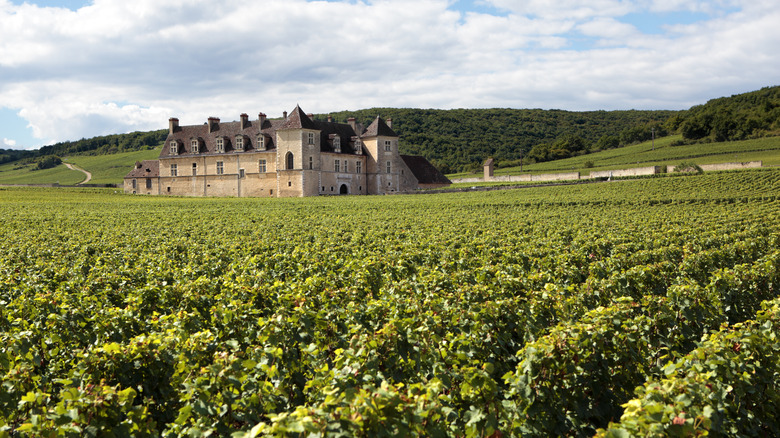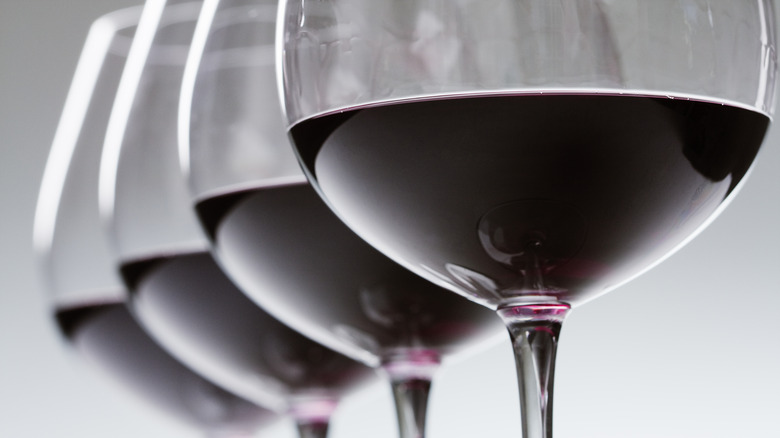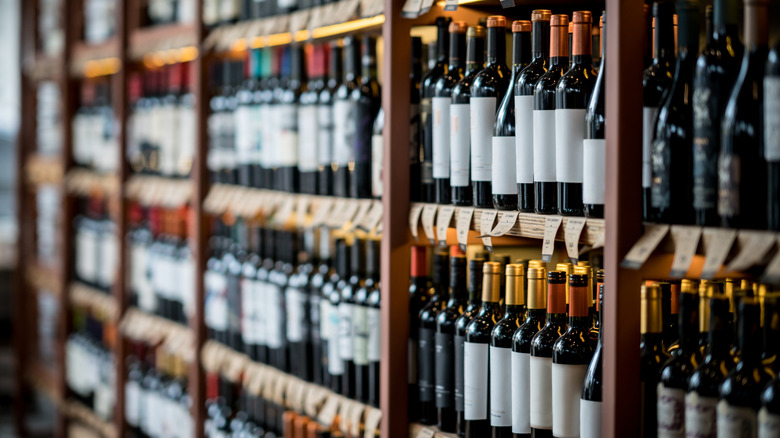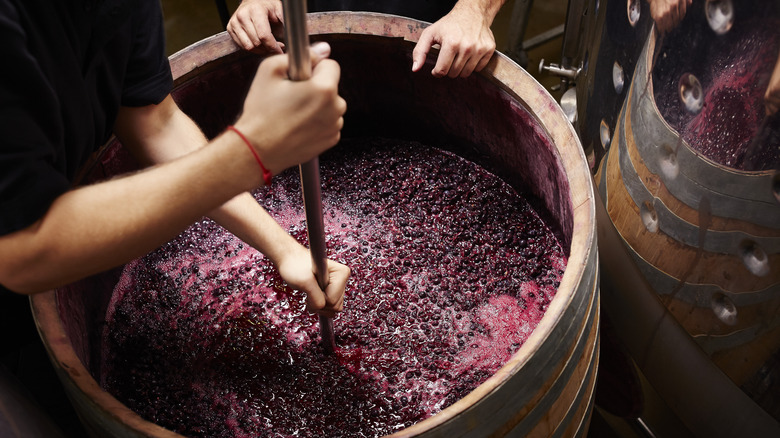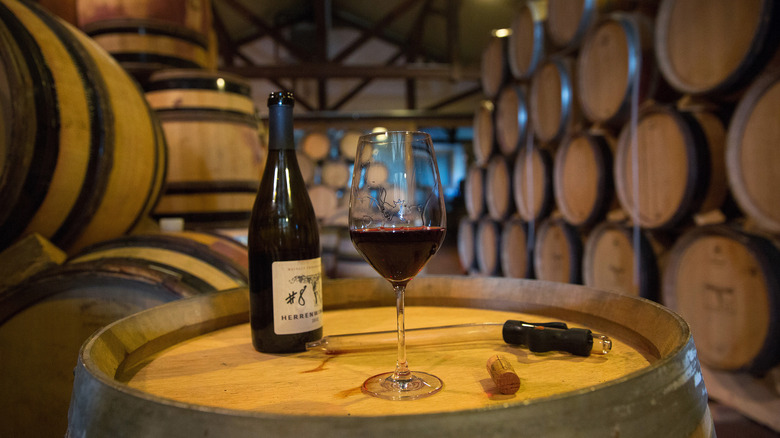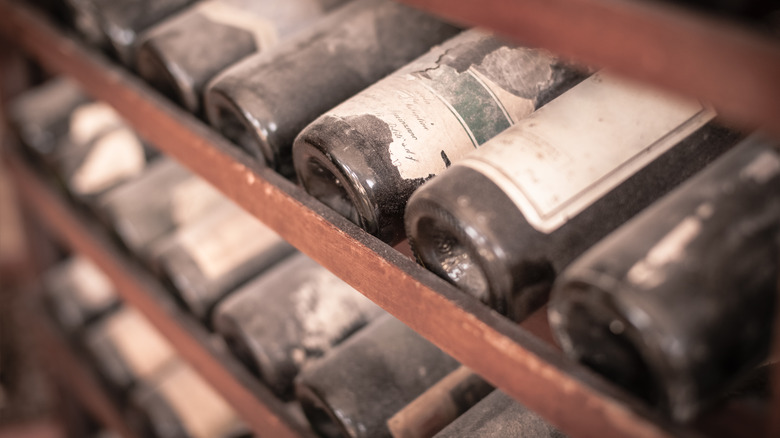A Guide To Pinot Noir: Everything To Know About The Red Wine
An incredibly versatile wine, pinot noir has fans worldwide. It's also grown in around 25 countries and is among the top five most popular grape varieties. Its widespread appeal comes down to its elegance, pleasant flavor profile, and low tannins, which make it a well-rounded option to serve with or without food. Of course, regional styles abound, and while you'll find some bold and fruity wines from warmer regions, cooler climates can display a more austere character.
The chances of finding a bottle of pinot noir on a restaurant menu or store shelf are greater than most varieties, and considering its ubiquity, it's well worth your time as a wine lover to understand the ins and outs of the famous grape. Although it's so common, there are significant differences in styles that might leave you confused as to whether you're sipping on the same variety. Read on to learn everything you need to know about pinot noir, the world-renowned red wine grape.
What is pinot noir?
Pinot noir is a red grape from Burgundy, France, first grown by the local monks and Dukes as early as the Middle Ages. As a parent to varieties like chardonnay, pinot noir also has many offshoots and genetic mutations. Other popular pinots like gris, blanc, and meunier (used in Champagne blends) stem from pinot noir, and it has multiple clones which are best suited for specific terroirs. Considering its varied genetics, a bottle of pinot from one region can taste significantly different from another — even if the vineyards are just a few hundred feet apart.
The variety is particularly adaptable to cooler climates since it tends to ripen with ease. Too much sun and heat and acidity will drop, altering the elegant nature of the wine. Compared with other red varieties, the grape skins are quite thin, affecting the resulting color of the juice, which is typically a paler — sometimes almost translucent — hue. Due to its delicate qualities, the grape can be hard to deal with in the vineyard, leading to its moniker as "the heartbreak grape." Nevertheless, successful examples sit at the apex of fine wines, and some of the world's most expensive bottles are pinot noir varietals.
Styles of pinot noir
Although pinot noir can vary notably between neighboring vineyards, two valuable ways to categorize the common styles are by comparing cool and warm climate wines, as well as those from old world and new world regions. Regarding the former, pinot noir certainly fares better in cooler climates thanks to its quick ripening characteristics. Here, the style is elegant and lighter-bodied, with an acidity that boasts freshness in every sip. With less dramatic ripeness, sugar levels are lower, and the resulting alcohol in the wine is also subdued. Contrarily, in warmer growing regions, the alcohol content tends to be higher. Although you won't find it growing in the hottest vineyards, more warmth offers a style of pinot brimming with rounded and juicy berry aromas. The wines are a bit weightier yet don't veer into full-body territory.
Meanwhile, old and new world styles of pinot can vary vastly. The former includes countries (mostly in Europe) where grapes are native, and winemaking has long been a tradition, whereas the latter consists of places where viticulture was eventually introduced. Burgundy, its homeland, is the benchmark style of old world pinot. Here the grape exudes an elegant profile, with delicate notes of fresh berries, forest floor, mushrooms, and a notable hint of acidity. On the flip side, new world regions like Oregon or New Zealand offer fuller-bodied fruity aromas with softer acidity. They also commonly age pinot in new oak barrels, layering the fruit with vanilla and notes of spice.
How much alcohol is in pinot noir?
The alcohol level in pinot is dependent on its growing conditions, as hotter areas with more sunshine boost the sugar content. More sugar in the fruit means more sugar that can be fermented into alcohol by yeast. Grown in Burgundy with its continental climate or Oregon with its coastal influence, pinot noir tends to stick to a medium alcohol level, from 11.5 to 13.5% alcohol by volume. Meanwhile, in sunny California, the grape has the conditions to further ripen and reach a medium-high degree, with alcohol by volume even reaching 15%.
These qualities translate to the wine's body and the consumer's perceived mouthfeel; lower alcohol comes off as lighter and increases as the wine gets boozier. Additionally, since there are many styles of lower alcohol pinot noir, it is an excellent wine to pair with food as it complements without overpowering the taste.
What does pinot noir taste like?
The taste of pinot is highly reflective of its terroir, which includes the climate, soil, and viticultural traditions of a vineyard area. Back in Burgundy, where pinot revered by collectors are grown, the grape offers elegant aromas of red fruit like cherries, strawberries, and raspberries, with hints of violet. An earthy element with aromas of dirt (in the best possible way!), mushrooms, and spice balances out the fruit with rustic notes. As the climate gets hotter, you may taste darker fruits like blueberries and blackberries on the palate.
Interventions in the cellar, such as barrel aging, can further alter the profile of this delicate grape. Baking spices like cloves, cinnamon, and nutmeg, as well as notes of vanilla, can shine through. Thanks to its acidity, sipping on a pinot offers a mouthwatering sensation that pairs well with food. The wine is usually pleasantly smooth, with minimal tannins to dry the palate. While regional variations exist, pinot noir is mostly made as a dry wine with little residual sugar. In some instances, a bottle can be perceived as sweeter, but it often comes down to the fruity profile.
Prime pinot noir growing regions
Due to its finicky nature in the vineyard, pinot noir doesn't grow everywhere. However, the regions that grow it successfully produce wines that are consumer friendly for casual wine drinkers and aficionados alike. As the heartland of the grape, Burgundy deserves the first mention. Here, the Côte d'Or is the prized location for the red grape, and you'll find wildly famous bottles from villages like Vosne-Romanée. It is also included in high proportion in sparkling wines from Champagne, the primary grape used in the Blanc de Noirs style. Elsewhere in Europe, fine examples are produced in Northern Italy and Germany, where the grape is known as spätburgunder.
In the U.S., Oregon has been growing pinot noir since the late '60s, and it has since reached international recognition for its delightful wines. Coastal California is making waves on the market, too, with Sonoma, Santa Barbara Country, Russian River Valley, and Carneros among the popular areas. Down in South America, coastal regions of Chile are doing well with the cool-climate-loving grape.
Oceania isn't left out of the pinot craze, and both Australia and New Zealand are bottling fine varietal wines. In Australia, the Yarra Valley, Victoria, and the island of Tasmania are prime pinot-growing regions, thanks to coastal influences and more subdued temperatures. Meanwhile, Central Otago on the South Island is revered in New Zealand for its refined and sophisticated pinot noir wines.
Pinot noir vs. other popular varieties
Pinot noir sales boosted rapidly following the release of the 2004 movie "Sideways," thanks to the main character's love of the grape and absolute dismissal of merlot. Merlot sales, on the other hand, definitely suffered from the hit and are only just beginning to rise again. Although the movie painted the grapes in such opposing lights, there is some overlap between the two, beginning with their origin in France. Whereas pinot noir is the star of Burgundy, merlot shines on the right bank of Bordeaux. It can tolerate slightly warmer climates and displays a softer acidity and fuller body. Its fruit aromas tend to evoke plums, cherries, and pomegranates, and it can have an underlying chocolate and tobacco character.
Cabernet sauvignon is certainly bolder and more full-bodied than pinot noir, with higher tannins and lower acidity. Also from the Bordeaux region of France, its tasting notes include darker fruits like blackberries and black cherries, as well as herbaceous and vegetal notes, such as green bell peppers. Cabernet is commonly matured in oak barrels, which add layers to the wine, with notes of tobacco, cedar, and spice.
Grapes pinot noir lovers would also like
If you've explored pinots from near and far, various other grape varieties offer similar characteristics to enjoy. Given the flavor range, you can seek wines that are more akin to cool-climate old-world or warm-climate new-world styles. In the former case, look to other cooler regions for lighter-bodied, lower alcohol, and higher acidity wine. For example, gamay grows just south of Burgundy in Beaujolais (which is technically part of Burgundy but stands on its own) and displays a similar fruit profile. Light tannins and a juicy mouthfeel make gamay a smooth and pleasant wine to enjoy, while more serious styles can resemble some of the praiseworthy wines of Burgundy.
Also in France, the alpine region of Jura is home to a few native red varieties that are packed with notes of fruit and earth yet light and delicate on the palate. Pick up a bottle of trousseau to see for yourself. Sicilian frappato may come from a warm place, yet it is lively and vibrant, and every sip exudes aromas of cherries, pomegranate, and white pepper.
For a bolder option that plays on berry fruits and spices, Spanish garnacha could be a revelation for a pinot lover. Similarly, Spanish mencía offers more complex aromas that highlight fruit, earth, and spice —the tenets of a fine red Burgundy.
How is pinot noir made?
Pinot noir follows typical red wine production, starting with its harvest in the vineyard. Due to its delicate thin skins, harvesting by hand in the early morning is the best way to retain the integrity and freshness of the fruit. In the cellar, the grapes are crushed and the juice is kept on the skins for a determined duration before being pressed off and discarded.
In some cases, some of the free-run juice that first comes off the grapes is separated to increase the concentration of the contents left behind, in a method known as saignée. Another technique to heighten the intensity of the flavor and color is to cold soak the juice with the skins after crushing.
The alcoholic fermentation takes place with the juice and yeast, and winemakers can choose the type of vessel this process takes place in. Stainless steel or concrete tanks and new or old oak barrels are some common examples. Thanks to its lighter nature, pinot can be bottled and released without extensive cellaring, though it can also age for a couple of years in barrels to add complexity.
Pinot noir food pairings
As a light to medium-bodied wine with a pleasant acidity and smooth tannins, pinot noir makes an excellent and versatile pairing with food. Cooler-climate styles make a great match for a charcuterie and cheese board, especially if it features goat cheese. Earthier wines will complement the flavors of mushroom-based dishes, such as risotto or even a mushroom-topped pizza. Meanwhile, fruitier warm-climate styles can stand up to grilled meat — a glass of pinot with a burger is an excellent duo, as highlighted in the book "Big Macs & Burgundy."
Too many people have integrated the mantra that red wine should be served with red meat and white wine with white meat, yet pinot offers an excellent balance that can dance on either side of this arbitrary line. While you might not want to drink pinot with a delicate sole fish, it works wonders with a grilled salmon filet or seared tuna steak. As the wine becomes more complex, pair it with roast chicken, other poultry like duck or turkey, and even leaner beef preparations. An elegant glass of pinot can enhance lightly-prepared game meat such as rabbit, venison, or lamb, showcasing its more complex qualities.
How to serve pinot noir
If you want to highlight the grape for its attributes, you'll want to start by serving it at the appropriate temperature. As a light to medium-bodied red wine, you should drink pinot slightly chilled. To enhance its characteristics, serve it at around 55 degrees Fahrenheit — certainly cooler than room-temperature as many people believe red wine should be served. If the wine is too warm, the alcohol is more obvious on the palate, and the freshness and elegance of the fruit are subdued. A good guideline is to pop the bottle into the fridge for a couple of hours and remove it about 20 minutes before serving.
If you have the shelf space for more glasses and love pinot noir, consider purchasing Burgundy glasses, designed specifically for the grape. The classic shape has a large bowl that narrows toward the top, allowing the aromas to spread out on the surface and remain concentrated on the nose as they exit the glass. Take it further by ensuring the glass has a thin rim so the wine seamlessly makes its way into your mouth.
Being a lighter grape, pinot doesn't require extensive decanting. However, you can pour the wine into another vessel and let it sit for 20 to 30 minutes before serving to allow some oxygen to pass through and open up the aromas. If you're sipping aged wine, be wary of decanting it for too long or the subtle notes can quickly fade away.
How long does pinot noir last?
If you are drinking a bottle of pinot noir right away, you don't have to bother storing it in optimal conditions. However, good storage is necessary if you are keeping an age-worthy bottle for longer. A wine fridge or temperature and humidity-controlled cellar is important to keep the space at around 50 to 55 degrees Fahrenheit. Make sure no direct light touches the bottles, and avoid keeping them anywhere with frequent vibrations, such as under the staircase.
Not all pinot can be matured for a long time; however, higher acidity styles made from reputed producers — most notably from Burgundy — have the potential to last for 10 to 20 years. As wine ages, its bolder features become subdued, and its fresh aromas take on different characteristics. While this is helpful with high-tannin full-bodied wines, pinot noir tends to be more refined and subtle. Wines made by prized producers become more complex and can take on interesting earthy and spiced aromas. In most cases, you'll want to drink a bottle of pinot within five to 10 years following its vintage.
If you opened a bottle at dinner and didn't get through it, pop the cork back on and refrigerate it for one to three days. If you transfer the remnants into a smaller vessel or use a vacuum pump, you can extend the shelf-life. The wine won't go bad, but its delicate features will be quickly compromised.
Nutritional information about pinot noir
Setting alcohol-related health issues aside, pinot noir offers some beneficial attributes. Notably, the grape's resveratrol content (an antioxidant) is greater than most other red wine grapes, as the president of a producer in Oregon told Forbes. The compound has antimicrobial properties, among others, which are typically produced at a higher rate in thin-skinned grapes and in those that grow in cool and humid climates. Increasing its resveratrol production allows the grape to protect itself from mold, yet it simultaneously means that the resulting wine is packed with more antioxidants too. Due to its fragile nature, exposure to oxygen can cause resveratrol to deteriorate. Although you might think an aged bottle of pinot gives you more bragging rights, younger wines are best when it comes to upping your antioxidant game.
Aside from antioxidants, pinot noir mostly contains carbohydrates from alcohol; an average 5-ounce glass contains about 120 calories, 0 grams of fat, and 3 to 4 grams of carbohydrates.
Why is pinot noir so expensive?
Sure, every type of wine has a range of prices from budget to totally outrageous. Nevertheless, it seems that to get a quality bottle of pinot, you have to splash out more than average. Its nickname, "the heartbreak grape," is a clue that this is no easy variety to grow in the vineyard. Pinot requires specific cool climate conditions with minimal humidity in order to avoid mold and ensure ideal ripeness levels. Considering the difficulty and extra work to grow it, growing good pinot costs more. More labor and precision translate to more time spent in the vineyard and cellar to produce a fraction of what could be made from a more straightforward grape.
Additionally, due to the strict regulations and low volume of wine from Burgundy — the peak of fine pinot — some bottles and producers have taken on a new level of rarity. In turn, this increases the price and creates a culture of awe surrounding a wine, which may explain why bottles from top vineyards like Domaine Romanée-Conti fetch such high prices.
